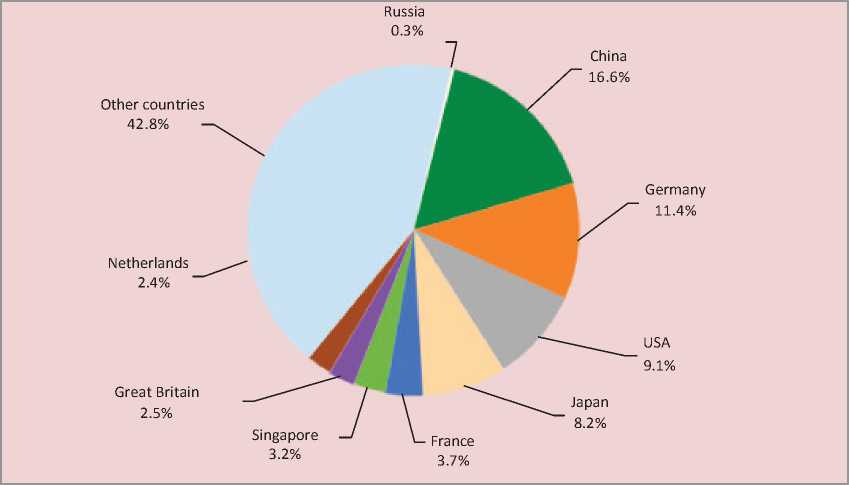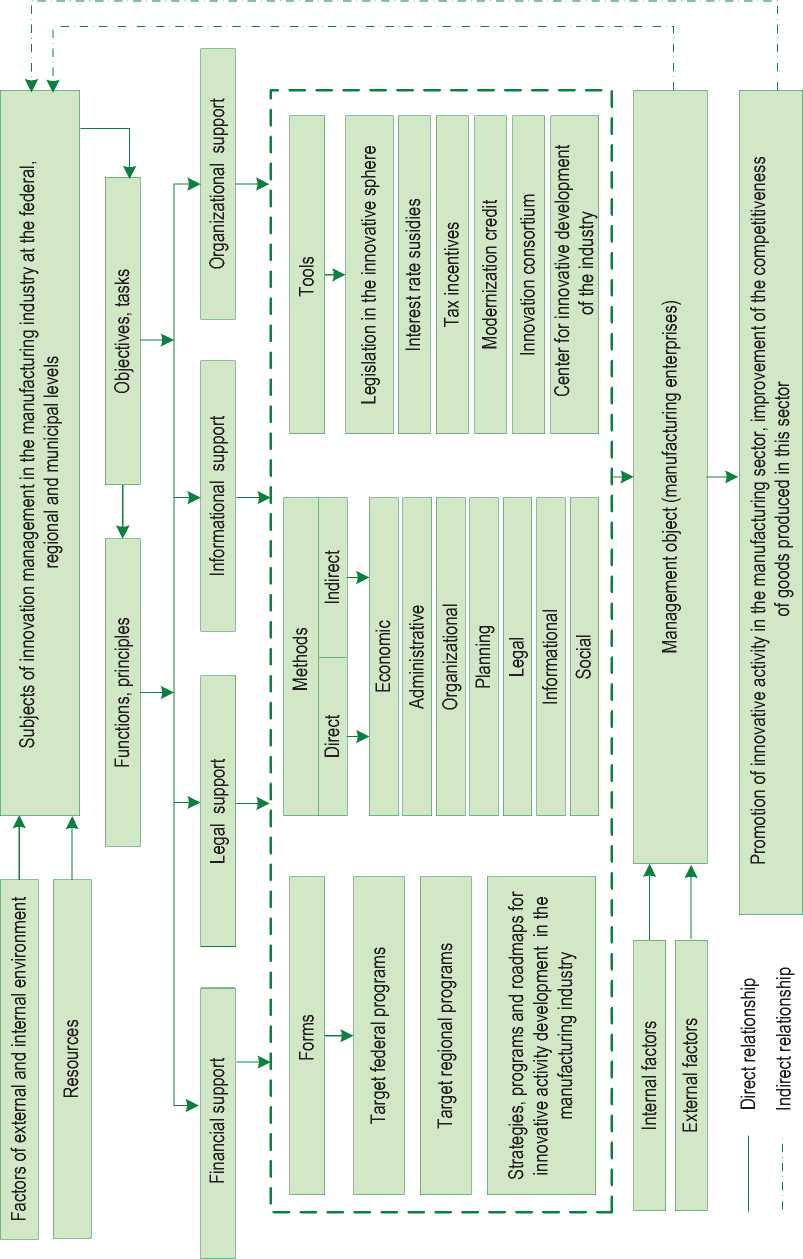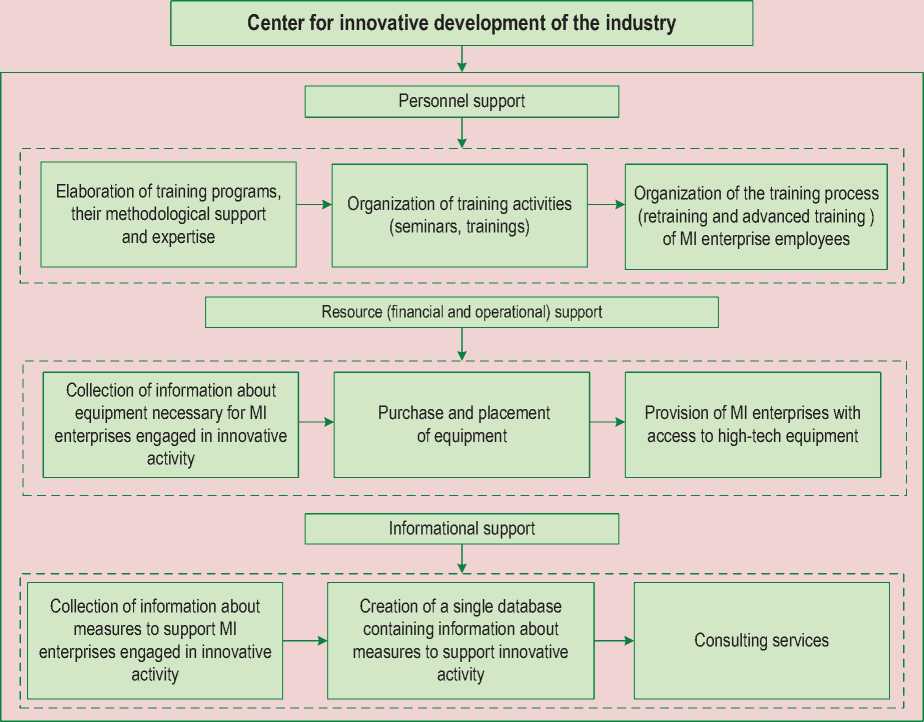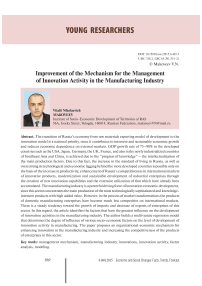Improvement of the mechanism for the management of innovation activity in the manufacturing industry
Автор: Makoveev Vitalii Nikolaevich
Журнал: Economic and Social Changes: Facts, Trends, Forecast @volnc-esc-en
Рубрика: Young researchers
Статья в выпуске: 4 (40) т.8, 2015 года.
Бесплатный доступ
The transition of Russia’s economy from raw materials exporting model of development to the innovation model is a national priority, since it contributes to intensive and sustainable economic growth and reduces economic dependence on external markets. GDP growth rate of 75-90% in the developed countries such as the USA, Japan, Germany, the UK, France, and also in the newly industrialized countries of Southeast Asia and China, is achieved due to the “progress of knowledge” - the intellectualization of the main production factors. Due to this fact, the increase in the standard of living in Russia, as well as overcoming its technological and economic lagging behind the more developed countries is possible only on the basis of the increase in productivity, enhancement of Russia’s competitiveness in international markets of innovative products, modernization and sustainable development of industrial enterprises through the creation of new innovation capabilities and the extensive utilization of that which have already been accumulated...
Management mechanism, manufacturing industry, innovations, innovation activity, factor analysis, modeling
Короткий адрес: https://sciup.org/147223745
IDR: 147223745 | УДК: 338.2 | DOI: 10.15838/esc/2015.4.40.13
Текст научной статьи Improvement of the mechanism for the management of innovation activity in the manufacturing industry
The manufacturing industry is one of the drivers of innovative development of the economy; this sector concentrates the main production of most technologically sophisticated and knowledge-intensive products with high added value. A variety of technological conversions, focused on manufacturing industry enterprises, on the one hand, makes this sector a major source of innovative products, goods and services and, on the other hand, is a major consumer of a wide range of innovative developments.
The manufacturing industry (MI) contributes to the country’s economic development greatly. In 2013 the enterprises of this branch provided almost 40% of GDP. The social significance is proved by the fact that it accounts for around 15% of the total employment in the economy ( tab. 1 ).
In the period of market transformations Russia witnessed a process of development of the innovative activity management mechanism, particularly in the manufacturing industry. This mechanism is a system with the following components:
procedures for determining priority research directions, a list of critical technologies, a method to develop and implement scientific, research and production programs of various levels and resource supply, technologies to use of obtained results, including problems to commercialize innovation and introduce intellectual property into economic circulation [4].
Nowadays the Russian Federation has a certain legal framework, aimed at promoting innovative activity in the manufacturing industry. The government has developed and adopted the laws “On Science and State Scientific and Technological Policy” and “On Industrial policy in the Russian Federation”, approved the “Strategy for Innovative Development of the Russian Federation for the Period up to 2020” and the state programs “Development of Industry and Improvement of its competitiveness”, “Economic Development and Innovative Economy”. Similar legal acts, strategies, programs and roadmaps are adopted at the regional level.
Table 1. Share of manufacturing in the economy of Russia, %
|
Indicator |
Year |
2013 to 2005, p.p. |
||||
|
2005 |
2010 |
2011 |
2012 |
2013 |
||
|
MI share in GDP |
41.1 |
40.8 |
40.7 |
40.4 |
39.3 |
-1.8 |
|
Value of fixed assets |
8.8 |
8.6 |
8.2 |
8.1 |
8.3 |
-0.5 |
|
Volume of export |
17.3 |
16.4 |
16.3 |
16.4 |
16.6 |
-0.7 |
|
Number of employees |
17.2 |
15.2 |
15.2 |
15.0 |
14.7 |
-2.5 |
|
Tax revenues to the budgets of all levels |
13.8 |
17.5 |
17.4 |
18.0 |
н\д |
4.2* |
|
Investment |
16.4 |
13.2 |
12.9 |
13.4 |
14.1 |
-2.3 |
* 2012 to 2005, in %.
Source: data of the Federal State Statistics Service of the Russian Federation. Available at:
The priority directions and key objectives of the state support for innovative activity are defined in the “Strategy for Innovative Development of Russia up to 2020”, approved by the RF Government decree of December 8, 2011 no. 2227-p. The key indicators stipulated by this document are the following:
– increase in the share of industrial enterprises engaged in technological innovation, from 10–15% to 40–50% in the total number of enterprises in industrial production;
– increase in the share of export of Russian high technology products in the total world export of high-tech goods from 0.3 to 2%;
– increase in the share of innovative products in the total volume of industrial products, from 5–7% to 20–35%.
However, despite the efforts the pace of innovative activity development in the manufacturing sector remains very insufficient for achieving the Strategy indicators and turning this sector into an engine of innovation development of the country’s economy. First of all, this is confirmed by the extremely low growth rate of innovative activity of the manufacturing enterprises.
Although these enterprises made a significant contribution (in 2013 – nearly 72%) to the formation of the total volume of innovative products, the level of innovation activity did not exceed 13% in 2005–2013 and the share of innovative products in the total volume of shipped products amounted to 12% (for comparison, in the European countries the level of innovative activity of industrial enterprises was much higher, for example in Finland – 52.5%, Germany – 71.8%, France – 40.1%). This indicates a low interest of domestic manufacturing enterprises in innovation ( tab. 2 ).
The low competitiveness of goods produced by the domestic processing complex, caused by the insufficient development of innovative activity, led to the fact that in 2012 Russia accounted only for 0.3% of the world market of engineering products ( fig. 1 ).
Table 2. Indicators reflecting the innovative activity development level in the manufacturing industry of Russia
|
Indicator |
Year |
2013 to 2005, p.p. |
||||
|
2005 |
2010 |
2011 |
2012 |
2013 |
||
|
Level of innovation activity of MI enterprises, % |
10.9 |
11.3 |
11.6 |
12.0 |
11.9 |
1.0 |
|
MI contribution to the total production of innovative products, % |
84.8 |
79.7 |
62.1 |
68.7 |
71.8 |
-13.0 |
|
Share of innovative products shipped by MI in the total volume of shipped goods, performed works and services, % |
7.0 |
6.7 |
6.8 |
9.6 |
11.6 |
4.6 |
Source: data of the Federal State Statistics Service of the Russian Federation. Available at:
Figure 1. Share of the countries in the world export of machinery and equipment in 2012

Sources: International Merchandise Trade Statistics. Available at: aspx?y=2012; Eurostat. Available at:
This situation necessitates the improvement of the existing mechanism to manage innovative activity in the manufacturing sector given the main factors influencing the development of innovation creation and implementation.
The identification of the factors having a great impact on the innovative activity development level in the sector under consideration is carried out on the basis of factor and correlation and regression analyses for the 2006–2013 period in all RF subjects (640 observation points).
The index reflecting the innovative activity development level in the manufacturing sector is chosen as an effective index. It is calculated by aggregating 4 indicators into the integral one:
-
1. Share of innovative products shipped by manufacturing enterprises, in the total volume of shipped products (this figure reflects the volume of innovative products, manufactured by the enterprises. High values of this ratio indicate that the enterprises of the manufacturing sector stimulate innovative activity and the diffusion of innovation is rather the faster).
-
2. Share of innovative products shipped by processing complex enterprises in the total volume of innovative products in the region (this figure also reflects the volume of innovative products, but it allows us to determine these enterprises’ contribution to the formation of the total volume of innovative products manufactured in the region).
-
3. Level of innovative activity of manufacturing enterprises (this figure allows us to estimate the degree of manufacturing industry’s involvement in innovation).
-
4. Volume of innovative products shipped by manufacturing enterprises, calculated per an employee (this indicator helps measure labor productivity in the production of innovative goods).
We have a sufficient statistical data base for 17 socio-economic indicators and can conduct quantitative and qualitative assessments. They are singled out as dependent variables.
The correlation analysis reveals that 8 of the 17 selected indicators have a fairly close relationship with the innovative activity development level in the manu-facturing industry. The statistical factor analysis helps group these 8 indicators into 3 components: financial (F), personnel (P) and manufacture (M). The financial component includes factors, such as a share of manufacturing enterprises’ expenditure on technological innovation in the total expenses on technological innovation; a share of investment in fixed capital of manufacturing enterprises in GRP; a ratio of average wages at manufacturing industries to average wages in the region’s economy. The personnel component includes factors, such as a proportion of employees engaged in research and development in the total number of economically active population; a number of protected titles for inventions and utility models per 10 thousand population; a share of population with higher education in the total employment in the economy; a number of organizations involved in research and development per 10 thousand population. The manufacture component includes only one indicator reflecting the degree of wear of fixed assets in the manufacturing industry.
We have a regression equation on the basis of the correlation-regression analysis of the resulting index (index, reflecting the innovative activity development in the manufacturing industry (IAMI) and the selected components ( tab. 3 ).
The quality of the obtained models is confirmed by the significant coefficients of multiple correlation and determination, as well as high values of F-tests. The regression equation coefficients prove that to the greatest extent the innovative activity development level in the manufacturing sector depends on the financial factors, which account for 27% of the variation (a share of personnel and manufacturing components accounted for 24% and 11%, respectively).
Table 3. Equation and its basic characteristic
|
Equation |
Model characteristics |
|
IAMI = 0.39 + 0.12 x F + 0.04 x p — 0.05 x m |
R correlation = 0.72; R2 determination = 0.52; F(3.636) F-test = 227.5; p= 0.0000001; |
|
IAMI – a index, reflecting the innovative activity development level in the manufacturing industry; F – a financial component; – P a personnel component; M – a manufacture component. |
|
According to the mathematical dependence, the increase in the innovative activity development level in the manufacturing industry can be achieved due to the growth of financial and personnel factors (the 1% increase in the financial and personnel components values involves the 0.12 and 0.04 increase in the index reflecting the innovative activity development level in the manufacturing sector, respectively), and the reduction of adverse production factors (the 1% decrease in the manufacture component value involves the 0.05 increase in the index reflecting the innovative activity development level in the manufacturing industry). Taking into account the identified factors, we can conclude that the functioning of the organizational-economic mechanism should be aimed at boosting innovation activity in the manufacturing industry by creating conditions for the improvement and development of financial, personnel and production capacities ( fig. 2 ).
The main goals of the proposed mechanism are the following: enhancing innovative activity, improving the competitiveness of goods produced in the studied industry. The formation and implementation of this mechanism is carried out by the federal, regional and municipal authorities on the basis of the relevant normative-legal acts in the field of innovation.
The structure of the mechanism to manage innovative activity in the manufacturing industry includes 4 blocks.
The first block is devoted to the financial support of innovative activity. It presupposes the study of financial resources that can be involved in the innovation process, terms and conditions of their mobilization, as well as the analysis of possible ways of their use.
The second block – legal support – is designed to form a legal basis and a favorable institutional framework to conduct innovative activity.
The third block includes information support. It is directed to provide a management subject with relevant and reliable information that will facilitate reasonable and timely management of innovation creation and implementation in the manufacturing industry.
The fourth block – organizational support – is aimed at creating the institutional structures required for initiation, development and monitoring of innovation management in the manufacturing industry.
We propose to use economic methods of direct (concessional lending; budget funding; grants; interest-free loans; price compensation; provision with public orders) and indirect impact (preferential taxation; restructuring of debt and enterprises’ payments; property support for innovators; regulation of prices and tariffs; financial support for the training and retraining of personnel; risk insurance, modernization loans), organizational (creation of specialized structures for the interaction between innovative activity participants), planning (development of strategies, programs and roadmaps for the development of innovative activities), legal (improvement of the regulatory framework), administrative (development of

the implementation process, examination, licensing and innovative project monitoring) and informational methods and tools (formation of the system of consulting services provision and the database of innovative projects).
The use of targeted support is the key direction to improve the methods and tools of the organizational-economic mechanism of innovative activity management in the manufacturing industry. It has regard to the degree of enterprises’ involvement in the innovative activities. This approach will help guarantee the integrated (financial, personnel, production) support for development, implementation and promotion of innovative products at all stages of the innovation cycle (tab. 4).
Table 4. Proposals to improve methods and tools of innovative activity management in the manufacturing industry according to the degree of enterprises’ involvement in the creation and implementation of innovation
|
Level of MI enterprises’ |
Content of the methods |
|
involvement in IA* |
and tools of innovative activity management |
|
MI enterprises having a full innovation cycle |
|
|
MI enterprises having at least half of the innovation cycle |
|
|
MI enterprises having one stage of the innovation cycle or not involved in the process of creating and implementing innovation |
|
* IA – innovative activity
Figure 3. Model of the functioning of the center for innovative development of the industry

The center for innovative development of the industry is one of the priority tools aimed at enhancing innovative activity in the manufacturing industry (fig. 3). Unlike other innovation infrastructure structures (a center for applied qualifications, a center for collective use, an engineering center, a technology transfer center, etc.) it helps, first, provide the integrated (financial, personnel, operational) support to the manufacturing industry for the development, implementation and promotion of innovation products on the market at all the stages of the innovation cycle; second, ensure the interaction of all participants of innovative activity within a single organizational structure; third, consider the degree of the manufacturing industry’s involvement in innovative activity.
The creation and development of the Centre should be financed from federal and regional budgets and enterprises’ funds. According to the RF Government Decree of
April 15, 2014 No. 316 “On Approval of the State Program of the Russian Federation “Economic Development and Innovative Economy” (Subprogram 5 “Promotion of Innovation” and Subprogram 7 “Personnel for Innovative Economy”), the necessity to elaborate and develop complex mechanisms to support innovation at all stages is one of the priorities. The state program “Economic Development of the Vologda Oblast for 2014–2020” (subprograms “Development of Certain Sectors of the Economy and Enhancement of Competitiveness” and “Science and Innovation in the Vologda Oblast”) stipulates the creation of conditions for modernization and innovative development of the region.
The effect from the Center’s activities is calculated on the basis of indicators, such as: a number of innovation developments in partnership with the Center for innovative development; a number of innovation developments implemented in the region’s manufacturing industry in partnership with the Center for innovative developments; a number of those undergone training in the total number of those who need training and reeducation;
efficient use of borrowed and available resources; relevance of the Centre’s methodological support for the learning process of innovative activity participants; a degree of wear of the basic production assets of the enterprises – members of the Centre; a number of protected titles for inventions and utility models, obtained by the Center members.
Thus, the problems of innovative activity development in the manufacturing industry are the following: shortage of financial resources, unattractiveness of the sector for investors, difficulty of obtaining borrowed funds, a high degree of wear of fixed assets, a lack of highly qualified specialists and a lack of consistency between innovative activity participants. Thus, the federal and regional authorities should focus on provision of comprehensive support to manufacturing enterprises and use economic, organizational and informational tools for it. It is necessary to guarantee targeted support for the manufacturing sector, taking into account the extent of their involvement in innovation and the socio-economic factors influencing the process of creation and introduction of innovation in the sector.
Список литературы Improvement of the mechanism for the management of innovation activity in the manufacturing industry
- Borisov V.N., Pochukaeva O.V. Modernizatsiya obrabatyvayushchei promyshlennosti RF na osnove ustoichivogo razvitiya otechestvennogo mashinostroeniya . Problemy prognozirovaniya , 2011, no. 2, pp. 55-63.
- Ilyin V.A., Gulin K.A., Uskova T.V. Intellektual’nye resursy kak faktor innovatsionnogo razvitiya . Ekonomicheskie i sotsial’nye peremeny: fakty, tendentsii, prognoz , 2010, no. 3, p. 14.
- Ilyin V.A., Povarova A.I. Problemy effektivnosti gosudarstvennogo upravleniya. Tendentsii rynochnykh transformatsii. Krizis byudzhetnoi sistemy. Rol’ chastnogo kapitala. Strategiya-2020: problemy realizatsii: monografiya . Vologda: ISERT RAN, 2014. 188 p.
- Innovatsionnaya politika: Rossiya i Mir. 2002-2010 .
- Ed. by N.I. Ivanov, V.V. Ivanov. Moscow: Nauka, 2011. 451 p.
- Mazilov E.A. Osnovnye indikatory i faktory innovatsionnogo razvitiya promyshlennosti regiona . Menedzhment i biznes-administrirovanie , 2013, no. 1, pp. 166-178.
- Makoveev V.N. Innovatsionnye protsessy v otechestvennom mashinostroenii . Menedzhment i biznes administrirovanie , 2013, no. 4, pp. 96-106.
- Aivazyan S.A., Mkhitaryan V.S. Prikladnaya statistika. Osnovy ekonometriki. T. 1: Teoriya veroyatnostei i prikladnaya statistika: uchebnik dlya vuzov: v 2-kh t. . 2nd edition, revised. Moscow: YuNITI-DANA, 2001. 656 p.
- Statistika. Praktikum: ucheb. posobie dlya vuzov . Ed. by I.I. Eliseev. Moscow: Yurait, 2011. 483 p.
- Terebova S.V. Promyshlennyi kompleks regiona: innovatsionnyi aspekt razvitiya . Problemy ekonomiki i menedzhmenta , 2011, no. 4, pp. 54-59.
- Terebova S.V., Vyacheslavov A.M. Innovatsionnyi klimat v regione: sostav i faktory razvitiya . Problemy razvitiya territorii , 2011, no. 3, p. 40.
- Federal’naya sluzhba gosudarstvennoi statistiki . Available at: http://www.gks.ru.
- International Merchandise Trade Statistics. Available at: http://comtrade.un.org/pb/CountryPagesNew.aspx?y=2012.
- Eurostat. Available at: http://epp.eurostat.ec.europa.eu.


